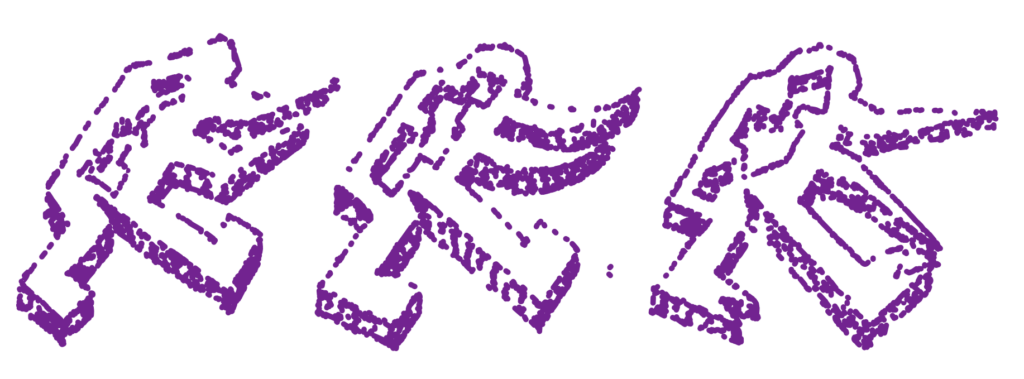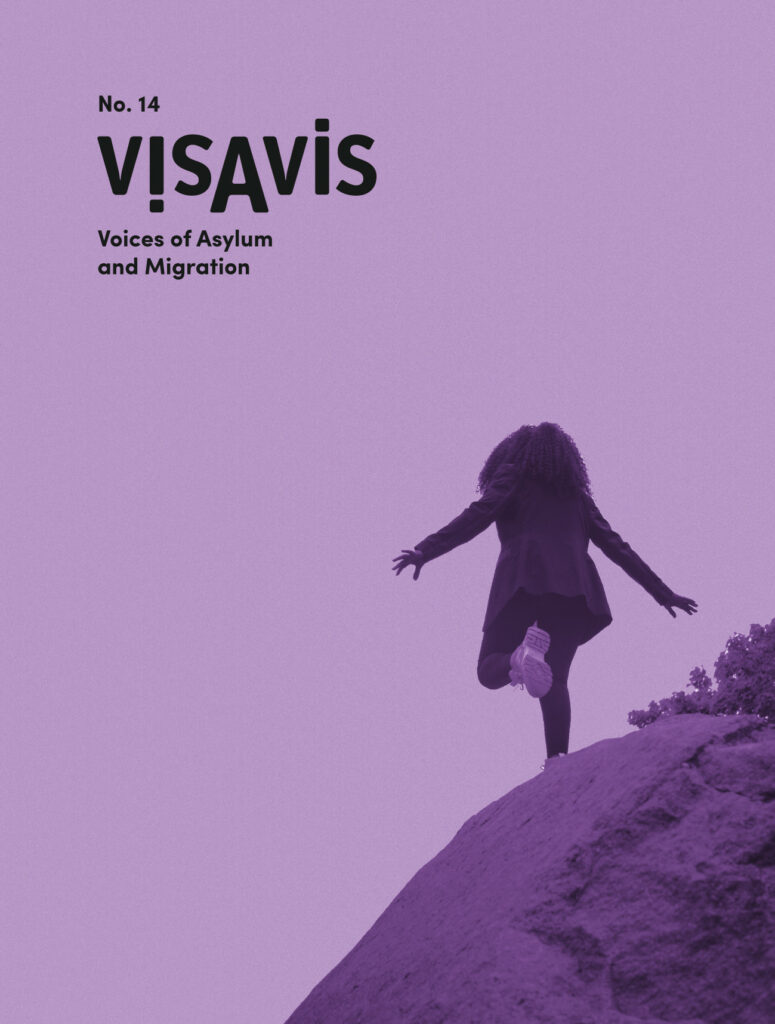
BY THE EDITORS • ILLUSTRATION BY ANDREA GAIDANO • NOVEMBER 2022
Standing on one leg is no way to live, but it is a skill. There are those with a firm piece of this Earth on which to place both feet, and there are those who have to learn to be wherever they can be.
Here is one trick: with more people standing together, supporting one another, the number of legs becomes more negotiable. But it’s still a skill.
Two things grew together out of almost nothing back in 2009. One was visAvis, this magazine; the other was Trampoline House, a community space in Copenhagen for refugees and asylum seekers. Both nearly ended in the pandemic year of 2020, when Trampoline House had to shut down and the visAvis editors were kept busy trying to support more immediate needs.
2022 was different, thanks to documenta fifteen. Improbably, the Trampoline House community became part of the artistic directorship of this, the world’s largest contemporary art event, and asked visAvis to come along for the ride. So it was that we found ourselves on Fridays and Sundays at Weekend Trampoline House, a miniature revival operating in a borrowed church parish hall.
documenta also gave us the opportunity to produce this issue at lumbung press, the collective print shop in Kassel. Given the international forum we chose to print this issue in English, breaking with the Danish–English tradition of the magazine in the interest of speaking to a larger audience.
This means it is also necessary for us to explain the state of migration and asylum in Denmark in 2022, and there is a lot to cover; even here in Denmark most people don’t bother to keep up with the developments unless they are in positions where their lives balance on them.
In our last editorial back in 2018, we wrote: “the season is ripe with spite.” It has proven to be a long, long season. The isolation that the Danish state creates for rejected asylum seekers in the deportation camps became almost total under the COVID-19 lockdowns. The government turned its most callous face on Syrian refugees by declaring Damascus and its surroundings safe for returnees (and deportees). The politics of racism continued to test and rattle the guardrails of what could be said aloud in Parliament and on Facebook.
But migrants still had a leg to stand on, and that’s all it takes, if you’re skilled. Camp residents and their friends outside found strategies to break down isolation. The Danish Syrian community successfully occupied the square in front of Parliament for more than a month of 2021, drawing supporters of all nationalities. Black Lives Matter DK has rallied tens of thousands of bodies and voices.
visAvis and Weekend Trampoline House have also been processes of constant destabilization and reaction. In February 2022, Ukraine was invaded. Denmark’s response was to move existing asylum seekers and rejected asylum seekers from bad camps to worse camps, sweeping them behind the curtain so Denmark could be seen receiving Ukrainians with open arms. Many Trampoline House participants were sent far away. Accounts from two of those moved, Behzad and Suliman, are recorded here in the piece Castaways in Kærshovedgård.
The response from our community was to ask the newcomers from Ukraine to join the club and sit down for coffee. These newcomers included the poet Vlada Riabinova, who wrote An explosion that changed lives, and her sister and translator Kristina. Although Denmark’s special treatment of Ukrainians made the double standards of the asylum system obvious, we celebrated the humanity that was extended to them, and we asked them to stand by all refugees – because we know how the position of new arrivals can change over time.
During these past years, our community has lost several friends to displacements and deportations. But despite the masses of land and water between us, these friends are present with us as we dream, as we fight, as we try to keep our balance. In one form or another, we are still here, we are still many, and we have made many things; including a new issue of visAvis.
Many of the contributors to this issue were with us in Weekend Trampoline House, and it was a place to share our struggles. Jean Claude Mangomba Mbombo, who contributed five poems, also remotely co-led a writing workshop with Helene Grøn that led to other pieces published here: The Banker’s The deadly asylum system of Denmark and Ali Gholami’s Justice for everyone. These are calls for help from those trapped in an impossible game.
Ksenia Grigoryeva and the Trampoline House Women’s Club produced the collage zine Resistance & Solidarity, reprinted in excerpt. Joachim Hamou’s puppet workshop connected Trampoline House’s space with collaborators in Kærshovedgård and ultimately the exhibition space at documenta.
Two other writers, Agob Yakoub in Away from home in search of a future and Shahla Namaki in her two pieces, add their own stories of finding new family and community in their country of Denmark (and Danish Kurdistan). Both of these writers focus on the ways we affect each other as human instances, consciously or not, near or far.
Those were participants who were present with us in the space of Trampoline House, sitting and talking and (not least) cooking together. In visAvis, those who could be there are joined by those who couldn’t. The anonymous S in Ellebæk prison shares his story through a conversation with David Reich, while Yadid in Kærshovedgård shares his via the comic artist Tzook Har-Paz. And from afar, Ali Ali sends a queer line of questioning out of Helsinki, and Naraki Abdelhadi an incisive migrant’s analysis of Europe’s pandemic.
In the summer of 2022, those with passports were able to go to Germany and build what they called their Castle in Kassel, yet another incarnation of Trampoline House – as exhibition. Eden Germa was there for the opening weekend, and reports on it in her piece Equal rights are cancelled in the dark.
The Danish newspaper Politiken was there, too, and their culture critic Mathias Kryger was unsure about the Castle’s success as art. “If Trampoline House transcended art in its time in an attempt to create an alternative space for people caught up in the Danish asylum system,” he asked, “how does that project stack up when it is now part of the world’s most important exhibition for contemporary art, documenta?”
For Kryger, “the big question in this context is how to show this social work in the exhibition format.” And, in his professional opinion, “while documenta fifteen as a whole is a long cavalcade of attempts at this discipline, the solution is far from found.”
That was the exhibition format, and this is paper. But in both cases, whether you agree with Kryger maybe depends on what he means by “the solution.” Is there really a solution to communicating need, loss and heartbreak – or even hope, healing and solidarity – to the whole world, whether they want to understand or not? As migrants in an often hostile country with power over us, we aren’t used to dealing in solutions. We can only keep our balance.
